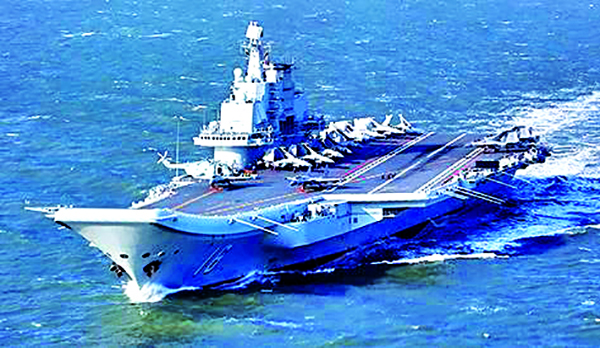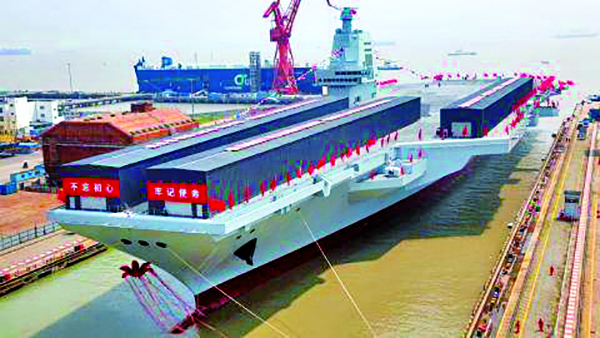Overview
Compared with Liaoning and Shandong, U.S. Navy aircraft carriers are larger (about 100,000 tons full load displacement), nuclear powered (giving them greater cruising endurance than a conventionally powered ship), able to embark and operate a larger number of aircraft (60 or more), and launch fixed-wing aircraft using catapults, which can give those aircraft a range/payload capability greater than that of aircraft launched with a ski ramp.
China’s third carrier, Fujian (Type 003), was launched (i.e., put into the water for the final stages of its construction) in on June 17, 2022. ONI expects the ship to enter service by 2024. It is expected to be conventionally powered, closer in size to U.S. Navy aircraft carriers, and equipped with catapults rather than a ski ramp for launching aircraft. China’s fourth carrier reportedly may have begun construction as early as 2021.
Observers have speculated that China may eventually field a force of four to six (or possibly more than six) aircraft carriers. In late November 2019, it was reported that the Chinese government, while deciding to proceed with the construction of the fourth carrier, had put on hold plans to build a fifth carrier, known as the Type 004, which was to be nuclear-powered, due to budgetary and technical considerations. Observers expect that it will be some time before China masters carrier-based aircraft operations on a substantial scale.
Liaoning (Type 001)
Liaoning is a refurbished ex-Ukrainian aircraft carrier that China purchased from Ukraine in 1998 as an unfinished ship. It is conventionally powered, has an estimated full load displacement of 60,000 to 66,000 tons, and reportedly can accommodate an air wing of 30 or more fixed-wing airplanes and helicopters, including 24 fighters. The Liaoning lacks aircraft catapults and instead launches fixed-wing airplanes off the ship’s bow using an inclined ski ramp.
Some observers have referred to the Liaoning as China’s “starter” carrier. China has been using Liaoning in part for pilot training. In May 2018, China reportedly announced that the aircraft carrier group formed around Liaoning had reached initial operational capability (IOC), although that term might not mean the same as it does when used by DOD in connection with U.S. weapon systems.
Shandong (Type 002)
Shandong is a modified version of the Liaoning design that incorporates some design improvements, including features that reportedly will permit it to embark and operate a larger air wing of 40 aircraft that includes 36 fighters. Its displacement is estimated at 66,000 to 70,000 tons.
Fujian (Type 003)
Earlier press reports had generally stated that Fujian might have a displacement of 80,000 tons to 85,000 tons. A November 29, 2020, press report, however, stated that satellite images of the ship under construction suggest that this estimate may be a bit low, and that Fujian might be closer in displacement to U.S. Navy aircraft carriers, which have a displacement of about 100,000 tons. Fujian is expected to be equipped with electromagnetic catapults rather than a ski ramp, which will improve the range/payload capability of the fixed-wing aircraft that they operate. A July 14, 2021, blog post stated that the ship might be launched (i.e., put into the water for the final stages of its construction) before the end of 2021.
China’s Fourth Carrier
A May 1, 2022, press report states: “Recent images of a stealth fighter jet at a naval airbase suggest China has begun pilot training preparations for a fourth aircraft carrier, defence experts say.” Some sources have stated that China’s fourth aircraft carrier would be built to the Type 003 design. Press reports from October 10, 2022, and March 13, 2021, however, suggest that the ship may be nuclear-powered rather than conventionally powered.
Commercial Heavy-Lift Ship Reportedly Used in Exercise as Helicopter Carrier
In August 2020, it was reported that China had used a commercial heavy-lift ship in a military exercise as a platform for operating at least two PLA Army helicopters.
Carrier-Based Aircraft
China’s primary carrier-based fighter aircraft is the J-15 or Flying Shark, an aircraft derived from the Russian Su-33 Flanker aircraft design that can operate from carriers equipped with a ski ramp rather than catapults, but which some observers have critiqued for its range/payload limitations in operations from carriers equipped with ski ramps rather than catapults. December 2021 press reports stated that China has developed an upgraded, catapult-capable version of the J-15 that could have improved range/payload when operated from a catapult-equipped carrier.
China reportedly plans to develop a carrier-capable variant of its J-20 fifth-generation stealth fighter and/or a carrier-capable variant of its FC-31 fifth-generation stealth fighter (reportedly now designated J-35) to complement or succeed the J-15 on catapult-equipped Chinese carriers.
China reportedly is also developing a carrier-based airborne early warning (AEW) aircraft, called the KJ-600, that is similar to the U.S. Navy’s carrier-based E-2 Hawkeye AEW aircraft, and stealth drone aircraft.
Roles and Missions
Although aircraft carriers might have some value for China in Taiwan-related conflict scenarios, they are not considered critical for Chinese operations in such scenarios, because Taiwan is within range of land-based Chinese aircraft. Consequently, most observers believe that China is acquiring carriers primarily for their value in other kinds of operations, and to demonstrate China’s status as a leading regional power and major world power. Chinese aircraft carriers could be used for power-projection operations, particularly in scenarios that do not involve opposing U.S. forces, and to impress or intimidate foreign observers.
Chinese aircraft carriers could also be used for humanitarian assistance and disaster relief (HA/DR) operations, maritime security operations (such as anti-piracy operations), and noncombatant evacuation operations (NEOs). Politically, aircraft carriers could be particularly valuable to China for projecting an image of China as a major world power, because aircraft carriers are viewed by many as symbols of major world power status. In a combat situation involving opposing U.S. naval and air forces, Chinese aircraft carriers would be highly vulnerable to attack by U.S. ships and aircraft, but conducting such attacks could divert U.S. ships and aircraft from performing other missions in a conflict situation with China.
Based on the US Congressional Reserach Service Report on China Naval Modernisation, Nov 2022



















